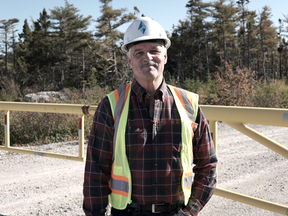
Rocket man: It could take a long, long time, but startup has lit the fuse for a NASA north
Fin Armsworthy was driving back to Canso, N.S., on a mid-September afternoon, negotiating the twists and turns of Route 16 in a passenger van while mapping out the future he envisions for a mostly forgotten corner of the province that has been consistently gripped by stories of loss, outbound migration and economic despair.
Results came in a 382 mAh/g for reversible capacity (RC), which is beyond what is expected for the best current commercially used synthetic graphite with an RC of 363 mAh/g. Data was collected from 5 separate coin cells for Ceylon graphite and for commercial synthetic supplier materials. The galvanostatic charts below illustrate these results:
The 65-year-old was born and raised in “Irishtown” — local speak for Canso — and he has witnessed the losses firsthand. Sometimes he will flip through his high school yearbook and see friends who moved away from the fishing village he still calls home.
Reminiscing can be a depressing exercise, but the Guysborough councillor isn’t wallowing in what once was. Instead, he’s brimming with optimism about what could be. And what he sees on the winding road leading to Canso are better days ahead, with good paying jobs, young families moving to town and tourists galore. Prosperity is at hand. You just need to believe in it.
“I tell you, it is a big thing,” Armsworthy said. “Launching rockets is the kind of game Steve has been playing all his life, just about, and I know there are some naysayers — hell, I have been one myself at different points in my life — but this is for real.”
Steve is Steve Matier, an American dreamer, former National Aeronautics and Space Administration engineer and rocket launch test site manager from White Sands, N.M., who moved his family to Halifax four years ago to build a commercial spaceport on the edge of the Atlantic Ocean, a seemingly far-out-there idea that might just get off the ground.

Construction is underway at the Maritime Launch Services Inc. (MLS) site near Canso, a tentative first orbital launch date is set for summer 2024 and prospective customers, keen to have their satellite clusters hitch a ride to the heavens, have inked non-disclosure agreements stating their intentions.
And Matier is now chief executive of a publicly traded, penny-stock rocket-launching entity in what a recent Citigroup Inc. report projects will be a trillion-dollar industry by 2040.
“There are a lot of things that can still go wrong with the project,” he said. “We still need more financing. We still need permissions, and rockets and everything else, but we are past that maximum dynamic pressure.”
Maximum dynamic pressure, or MAXQ, is NASA-engineer-speak for the moment during launch when a rocket hasn’t yet reached space, but has passed the point where everything mechanical can blow apart in a blink.
Reaching MAXQ doesn’t mean no more risks are ahead, but it is the Hollywood moment when all the rocket scientists at mission control pull their headsets off and cheer.
MAXQ is also Maritime Launch Service’s ticker on the neophyte NEO exchange, which speaks to its CEO’s endearing, unflinching, space-loving geekiness.
Of course, there have been more days, and nights, than the 64-year-old cares to count when he was close to throwing in the towel, as the investors he figured would be banging on his door weren’t knocking, and the number of seabird studies undertaken to show blasting rockets into space eight times a year wouldn’t cramp its feathered visitors style exceeded two dozen.
A $10.5-million private funding round in May 2021 followed by a public listing this past April has eased Matier’s existential angst about getting to the initial launch stage, but it hasn’t eliminated the competitive pressure the company faces.
Building and launching rockets was once a government preserve, but the ground has shifted, with officials ceding turf to commercial space ventures underwritten by private billionaires: Elon Musk’s Space Technologies Exploration Corp. (SpaceX), Sir Richard Branson’s Virgin Galactic Holding Inc. and Jeff Bezos’ Blue Origin LLC.

There are other established players with proven track records, too. For example, Colorado-based United Launch Services LLC has 150 successful launches to its credit, which is exactly 150 more launches than MLS.
Matier remains undaunted, because none of his competitors possesses a chunk of land on the ocean’s edge in rural Nova Scotia that gives his spaceport a clear shot at putting satellites into polar orbit.
“This is where the industry wants to put its satellites,” he said. “Because of our location, with thousands and thousands of miles of open ocean to the south of us before you hit South America or Africa, we have a real advantage.”
Long before Canso was a gleam in Matier’s eye, he and his wife, Anne, got hooked on genealogy, and discovered she had an ancestor — last name, McLay — who worked in the Cape Breton coal industry. They may have been living in New Mexico, but the Maritimes was at the top of their travel bucket list.
Now, the couple own a home in Halifax, are in mid-application for permanent residency papers and are considering becoming Canadian citizens.
“I am not allowed to screw up this project because of my wife’s heritage,” he said.
Building a spaceport, with all the state-of-the-art doo-dads, could cost more than $200 million. Matier said MLS doesn’t need to build a “field of dreams” to get to that first launch, but he still needs more money for the company to truly take flight.
Among those helping him find investors is Sasha Jacob. He is chair of MLS’s board and bought into Matier’s vision early on to the tune of a $500,000 stake. He also runs Toronto-based Jacob Capital Management Inc., and he is a space nerd whose great-uncle, Josef Blumrich, was a NASA engineer.
“Instead of becoming a smart, science-based person, I became an investment banker,” he said.
Jacob also knows people who know people.

Years back, former Ontario premier Ernie Eves was executive chairman of Jacob Securities, the renewables-sector focused investment bank Jacob launched in 2007. The firm later ran afoul of the Investment Regulatory Industry Organization of Canada, post-Eves era, netting its namesake a $100,000 fine in 2017. However, the regulator noted Jacob did not appear to have acted “maliciously” and no evidence was presented “that any clients were harmed.”
“It was a supervision citation,” he said, from Bora Bora, where he was vacationing with his wife.
Jacob has long been a player in the penny-stock realm, a dicey arena, but sometimes those bets pay off. What appealed to him in this case was Matier’s NASA pedigree, the projected growth of the space industry, the evolving regulatory environment around it and the big picture notion that Canada as a country is going to want to, well, reach for the stars, so why not start that journey on the East Coast?
“We see opportunities to get involved in things before they are effectively owned by the bank,” he said.
Jacob isn’t the only person Matier has made a good impression upon. Another board member, François Desjardins, is the former chief executive of Laurentian Bank of Canada.
A big part of the pitch involves the company’s location. No one had been talking about Canso as a town with a future until Matier appeared on the village’s doorstep five years ago. Lately, he has been talking about launches as major potential tourist draws; how space industry-related companies tend to cluster near launch sites; how the operational nuts and bolts of a spaceport rely upon the trades — electricians, pipe-fitters, technicians — and not a bunch of PhDs.
“We don’t need 30 different geeks with slide rules in Canso, that is not how it is done today,” Matier said.
Lest it be overlooked: the Maritime provinces have a long history of so-called smokestack chasing. (Anybody out there remember Malcolm Bricklin and his eponymous sports car?) A red carpet gets rolled out, industry players are wooed to consider opening the next big thing, and the hypothetical project gets touted by its champions for the jobs, spin-off industries and taxes it will surely create.
“It’s a strategy that does not have a very good track record,” Karen Foster, Canada Research Chair in Sustainable Rural Futures for Atlantic Canada and associate professor of sociology at Dalhousie University in Halifax, said. “People are right to be skeptical.”
What, perhaps, is different about Matier is that he was just about the only guy doing the wooing for years. Banging on doors, cap in hand, asking for money, asking for people to see what he so clearly could: a unique opportunity for Canada to have a domestic commercial spaceport, instead of forever having to hitch a ride with someone else, someplace else.
“People need to look at whether they believe we are for real or not,” he said.
Councillor Fin Armsworthy has done his share of looking, and he sees a village drained of its youth
“We have missed so many chances,” he said. “I think we got to take the game the way it goes, and this spaceport is the perfect opportunity.”